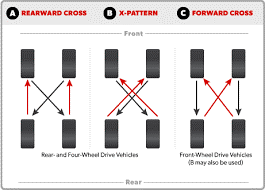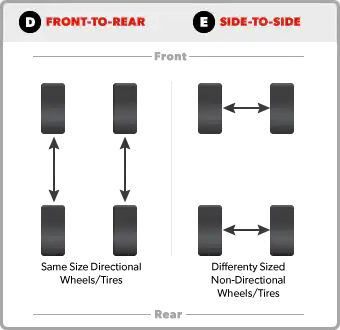Tire Rotation: Here’s What You Need To Know
The average tire begins wearing down after five years of driving. And if you drive more than the average American, which is 14000-15000 miles, you’ll start seeing signs of wear and tear even earlier.
This means incurring a hefty cost of getting your tires changed which may cost anywhere between 400 to 1800 dollars. But fear not, there exists a solution to extend the life of your tires – saving you both valuable time and money.
What Is Tire Rotation?
Tire rotation, as the name suggests, is the process of rotating your tires so that all four wheels of a vehicle are used equally. Usually, the front tires tend to wear out faster than the rear ones. This is because the majority of the weight of the car is in the front causing more wear and tear. Other aspects, such as turning and cornering, also make the front tires wear out quicker in contrast to the rear ones.
How Often Should You Get Your Tires Rotated?
The first step to figuring out how often you need to get your tires rotated is to check your vehicle’s owner manual. Manufacturers often mention the recommended tire rotation schedule in the manual. The general consensus about the time period to rotate your tires, however, is considered to be around every six months or the equivalent of driving which is between 6000 to 8000 miles.
Why Should I Get My Tires Rotated?
By rotating your tires periodically, you can neutralize the damage done to your wheels by delaying wear and tear.
Safety Hazard
The US Department Of Transportation reported around 11,000 tire-related accidents, almost all of which could have been prevented if proper tire maintenance was practiced. Hence, by rotating your tires, you’re not only saving money, but also potential lives.
Moreover, if tires are unequally worn out, sudden turns and breaks can turn into dangerous situations.
Decreased Noise And Vibration
Excessive wear and tear can increase your vehicle’s vibration. This may especially be visible when turning your steering wheel. Additionally, worn-out tires can also increase road noise, making your driving experience as well as of those around you very uncomfortable.
Fuel Efficiency
Additionally, tire wear and tear can lead to lower performance which can reduce fuel efficiency by up to 3%. Although this may not seem like such a big amount, it can up to be very pricey, especially with inflation and rising fuel costs. All of this adds up to be costly, while also contributing towards environmental degradation.
When your tires are rotated regularly, the amount of effort required by the car decreases. This translates to even wear and tear which means traction, stability, and vehicle pull are all neutralized. This lets a car run smoothly requiring less gas to fuel the car. In other words, it means less fuel costs for you with a smoother driving experience.
Maintain Traction
If you live in especially rainy or snowy areas then you know the importance of tire traction. Wheels that are worn out excessively will be more prone to breaking traction and spinning out of control. This is very dangerous and can result in some serious accidents.
Tire traction is very important car and non-car enthusiasts alike. For instance, if you were to take your car to mountainous or hilly areas with wet or even dry roads, you need significant traction in your car.
This is possible through frequent rotation of your tires.
Cost-effective Method
Getting your tires rotated should cost around $50 or be even cheaper depending on where you’re located. Moreover, you could also bring down the costs to $0 by learning how to rotate your tires yourself. This option, although cheap, may be time-consuming initially. YouTube has a number of options available where you can find step by step tutorials. Additionally, there are a plethora of articles also available on the internet even providing links to buy your tools.
Learn how to rotate your tires here.
Tire Rotation Patterns
Rearward Cross
This is mainly for four-wheeled, rear wheeled, and all-wheel drive cars. The rear tires move straight to the front whereas the front tires move across to each corner tire.
X Pattern
Each front tire moves in place of the rear tire opposite to it. This is recommended mainly for front-wheel drive vehicles such as a sedan.
Forward Cross
This is the most common and preferred pattern by tire rotation practitioners for front wheel-drives. The rear tires move forward in opposite directions whereas the front wheels move directly back.
Source: TireRack
Front To Rear
This is for the same size directional wheels. Each front wheel exchanges places with the respective wheel in the back.
Side To Side
This is used for vehicles with differently sized non-directional wheels. Each tire exchange places with the wheel on its side.
Which Tire Rotation Pattern Should I Use?
This decision ultimately depends on the type of vehicle you have, the tires are you using, and if your vehicle is a front, rear, or all-wheel-drive. It also depends on the size of your tires, if they’re the same size or not or if your tires are non-directional or directional. However, the most common and traditional tire rotation patterns are the first three mentioned. They cover most cars being used. The Tire and Rim Association, the tire standardizing body recommends any of the first three. These are the Rearward cross, X Pattern, and the Forward Cross.
Conclusion
And so, because of the reasons mentioned above, you can see the importance of rotating your car’s tires. Tires make up a very essential part of a car. And just like other things, tires also need maintenance. The pros of tire rotation heavily outweigh the cons which further solidifies its need. Doing so will result in a much more beneficial, cost-effective, smoother drive.



If I have a 2004 rear wheel drive BMW, how do I rotate the tires.??